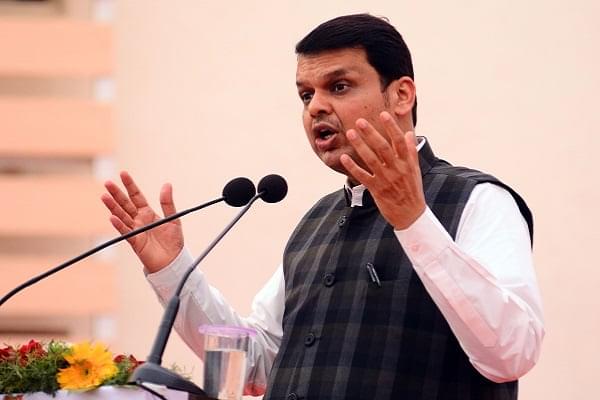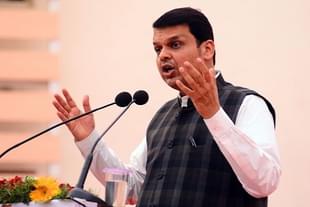Politics
How Fadnavis' Water Management Plans Were Stalled By Maharashtra's Political Instability
Nimish Joshi
Aug 25, 2024, 04:39 PM | Updated 04:46 PM IST
Save & read from anywhere!
Bookmark stories for easy access on any device or the Swarajya app.


“Water Wars” is a familiar term, part of the global geopolitical lexicon for several years now. Strategic analysts have long predicted impending regional and international conflicts, on account of paucity of water for humankind.
While the issue is well-recognized even in India, solutions are hard to come by.
It is in this context of uncertainty and anxiety, that this piece seeks to discuss former Maharashtra Chief Minister and present Deputy Chief Minister Devendra Fadnavis’ three big ideas for water conservation and management.
Maharashtra’s Water Scarcity
Maharashtra has severe regional variations in the rainfall it receives every monsoon season. The Marathwada and Vidarbha regions often remain parched, with uneven spatial and temporal distribution of rain. The irrigation potential of the state is limited due to the geographical complications.
The state’s vast coastline and green hill stations capturing monsoon-season beauty stand side-by-side with desiccated interiors. This situation leads to yearly agrarian woes. Fadnavis was the first Chief Minister in the state to seek long-term and structural solutions to this towering issue, with three signature ideas.
Jalyukt Shivar Abhiyan
The ‘Jalyukt Shivar Abhiyan’, which literally means water-filled land program, was aimed at reviving and creating local water bodies, conserving small-scale water sources and creating a mini-network of canals in drought-prone villages.
This program was launched days after Fadnavis assumed office as Chief Minister in 2014.
The program focused on local, small solutions. Measures like connecting local water streams to larger water bodies, creating percolation tanks and bunds and de-silting existing water bodies, including use of cement lining to ensure permanent water retention and storage were implemented.
The Jalyukt Shivar Abhiyan made steady progress in reviving farm-based water bodies and reducing the dependence on irrigation water and hence monsoons. However, with the political changes in the state after 2019, the program lost its way.
However, the idea was validated when Prime Minister Modi talked about each Indian district creating 75 ‘Amrit Sarovars’ – district level water bodies – in the 75th year of India’s independence.
Marathwada Water Grid Project
The Marathwada region of the state faces the biggest water shortage troubles. The “Latur water train” of 2016, where a whole city had to be supplied water through specially run water trains, was a stark crisis management initiative, incidentally also taken during Fadnavis’ Chief Minister tenure.
His learning from that experience was to find long-lasting solutions, which would obviate the need for yearly patchwork. The Marathwada water grid project was the big idea he proposed, which involved linking of all irrigation projects in Marathwada so that this network could quench the region’s thirst.
There were some initial talks of tapping Israel’s water management expertise for this program. This project has been recently revived by the Maharashtra government, which is now seeking World Bank funding to kickstart it. The state has also sought the help of the central government for this inventive program.
Maharashtra River Linking Program
River linking as a solution to address India’s water availability imbalance is an old idea. Interlinking of major Indian rivers was a cherished dream of ex-President Dr. A.P.J. Abdul Kalam.
As far back as 1980, central government agencies had talked about a Par-Tapi-Narmada Link, which would have benefited northern Maharashtra apart from the Saurashtra and Kutch regions in Gujarat. Fadnavis had shook the dust off this long-pending project as Chief Minister.
Yet another of his initiatives has been recently revived, but in a different context. The Wainganga-Nalganga river linking project has recently been approved by the state government.
This project aims to address the water scarcity in the Marathwada and Vidarbha regions, and benefit 15 towns in six districts.
This project is planned to be not just irrigation-specific, but also to bring drinking water and industrial water supply to various towns located around the project area. This is of course a long-gestation project, with a proposed ten year completion plan.
Way Forward
These three big-bang ideas demonstrate that big systemic plans can indeed be conceptualised but the execution of such ingenious ideas needs political will, apart from the ability to raise financial and operational resources.
The political will emanates from political continuity and certainty.
And this has been a big gap for Maharashtra in the last 10 years. Although the state is the growth engine of the Indian economy, frequent changes to state’s governing political configuration have taken a huge toll on ideas like these three water projects.
This is in stark contrast to the rapid and purposeful decision-making seen during Fadnavis’ tenure as Chief Minister. With his presence in the current government, these ideas are back on the table, but the state has lost precious time, while the thirsty lands and people await redemption.
If these projects are completed, these will be yet another contribution from Maharashtra to the nation as a whole, maintaining its track-record of leading from the front in solving big national problems.
Nimish Joshi is Director, Smahi Foundation of Policy and Research.
Nimish Joshi is Director, Smahi Foundation of Policy and Research.





